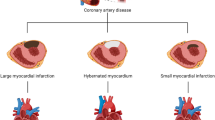Abstract
Objective Chronic adenosine A2b receptor stimulation has been shown to prevent ventricular remodelling after myocardial infarction (MI). We hypothesized that this effect is due to the inhibition of cardiac myocyte apoptosis in the myocardium remote from the infarction. Methods Rats were subjected to MI by LAD ligation in situ. Some animals were pre-treated with the stable adenosine analogue 2-chloro-adenosine (CADO). After 24 h, pro- and anti-apoptotic signals (protein kinase C isoforms, p38, g proteins, Bcl-2/Bax ratio, Akt, Bad), and marker of apoptosis execution (caspase-3, TUNEL) were quantified in the remote myocardium. Results CADO prevented the occurrence of apoptosis in the remote myocardium of an infarcted heart. This effect occured not only when CADO was started before the onset of ischemia but also when it started 3 h after the infarction. The anti-apoptotic effect of CADO was blocked by simultaneous administration of the selective adenosine A2b receptor antagonist MRS1754 (1 mg/kg). The anti-apoptotic effect of CADO seems to be mediated by gαq and by the activation of survival kinases (Bad) and by inhibition of the pro-apoptotic PKC-δ/p38-MAPK-pathway. Conclusion Chronic adenosine A2b receptor stimulation blocks cardiac myocyte apoptosis in the remote myocardium even when started after the onset of infarction. This may explain the anti-remodelling-effect of the A2b receptor stimulation after infarction.






Similar content being viewed by others
References
Mann DL (1999) Mechanisms and models in heart failure: a combinatory approach. Circulation 100:999–1008
Pfeffer MA, Braunwald E (1990) Ventricular remodeling after myocardial infarction. Experimental observations and clinical implication. Circulation 81:1161–1172
Opie LH, Commerford PJ, Gersh BJ, Pfeffer MA (2006) Controversies in ventricular remodeling. Lancet 367:356–367. doi:10.1016/S0140-6736(06)68074-4
Cheng W, Kajstura J, Nitahara JA et al (1996) Programmed myocyte cell death affects the viable myocardium after infarction in rats. Exp Cell Res 226:316–327. doi:10.1006/excr.1996.0232
Simonis G, Wiedemann S, Schwarz K et al (2008) Chelerythrine treatment influences the balance of pro- and anti-apoptotic signaling pathways in the remote myocardium after infarction. Mol Cell Biochem 310:119–128. doi:10.1007/s11010-007-9672-6
Pfeffer MA, Lamas G, Vaughan DE, Parisi AF, Braunwald E (1988) Effect of captopril on progressive ventricular dilatation after anterior myocardial infarction. N Engl J Med 319:80–86
The Delta-MI investigators (2008) Intracoronary KAI-9803 as an adjunct to primary percutaneous coronary intervention for acute ST-segment elevation myocardial infarction. Circulation 117:886–896. doi:10.1161/CIRCULATIONAHA.107.759167
Wakeno M, Minamino T, Seguchi O et al (2006) Long-term stimulation of adenosine A2b receptors begun after myocardial infarction prevents cardiac remodeling in rats. Circulation 114:1923–1932. doi:10.1161/CIRCULATIONAHA.106.630087
Lasley RD, Kristo G, Keith BJ, Mentzer RM Jr (2007) The A2a/A2b receptor antagonist ZM-241385 blocks the cardioprotective effect of adenosine agonist pretreatment in in vivo rat myocardium. Am J Physiol Heart Circ Physiol 292:H426–H431. doi:10.1152/ajpheart.00675.2006
Philipp S, Yang XM, Cui L, Davis AM, Downey JM, Cohen MV (2006) Postconditioning protects rabbit hearts through a protein kinase C-adenosine A2b receptor cascade. Cardiovasc Res 70:308–314. doi:10.1016/j.cardiores.2006.02.014
Feoktistov I, Biaggioni I (1997) Adenosine A2B receptors. Pharmacol Rev 49:381–402
Dixon AK, Gubitz AK, Sirinathsinghji DJ, Richardson PJ, Freeman TC (1996) Tissue distribution of adenosine receptor mRNAs in the rat. Br J Pharmacol 118:1461–1468
Grdeń M, Podgórska M, Szutowicz A, Pawelczyk T (2005) Altered expression of adenosine receptors in heart of diabetic rat. J Physiol Pharmacol 56:587–597
Solenkova NV, Solodushko V, Cohen MV, Downey JM (2006) Endogenous adenosine protects preconditioned heart during early minutes of reperfusion by activating Akt. Am J Physiol Heart Circ Physiol 290:H441–H449. doi:10.1152/ajpheart.00589.2005
Schwarz K, Simonis G, Yu X, Wiedemann S, Strasser RH (2006) Apoptosis at a distance: remote activation of caspase-3 occurs early after myocardial infarction. Mol Cell Biochem 281:45–54. doi:10.1007/s11010-006-0233-1
Daugas E, Susin SA, Zamzami N et al (2000) Mitochondrio-nuclear translocation of AIF in apoptosis and necrosis. FASEB J 14:729–739
Hayasi M, Tsutamoto T, Wada A et al (2003) Immediate administration of mineralocorticoid receptor antagonist spironolactone prevents post-infarct left ventricular remodeling associated with suppression of a markter of myocardial collagen synthesis in patients with first anterior myocardial infarction. Circulation 107:2559–2565. doi:10.1161/01.CIR.0000068340.96506.0F
Holtz J (1998) Role of ACE inhibition or AT1 blockade in the remodeling following myocardial infarction. Basic Res Cardiol 93(Suppl 2):92–100. doi:10.1007/s003950050228
Schulte G, Fredholm BB (2003) The Gs-coupled adenosine A2b receptor recruits divergent pathways to regulate ERK1/2 and p38. Exp Cell Res 290:168–176. doi:10.1016/S0014-4827(03)00324-0
Shizuduka Y, Buttrick PM (2001) Protein kinase C epsilon modulates apoptosis induced by beta-adrenergic stimulation in adult rat ventricular myocytes via extracellular signal regulated kinase (ERK) activity. J Mol Cell Cardiol 33:1791–1803. doi:10.1006/jmcc.2001.1442
Chen L, Hahn H, Wu G et al (2001) Opposite cardioprotective actions and parallel hypertrophic effects of δ- PKC and ε-PKC. Proc Natl Acad Sci USA 98:11114–11119. doi:10.1073/pnas.191369098
Heidkamp M, Bayer A, Martin JL, Samarel AM (2001) Differential activation of mitogen-activated protein kinase cascades and apoptosis by protein kinase C epsilon and delta in neonatal rat ventricular myocytes. Circ Res 89:882–890. doi:10.1161/hh2201.099434
Shizuduka Y, Buttrick PM (2002) Protein kinase C zeta modulates thromboxane A2 mediated apoptosis in adult ventricular myocytes via Akt. Am J Physiol 282:H320–H327
Tanaka Y, Gavrielides MV, Mitsuuchi Y, Fujii T, Kazanietz MG (2003) Protein kinase C promotes apoptosis in LNCaP prostate cancer cells through the activation of p38 MAPK and inhibition of the Akt survival pathway. J Biol Chem 278:33753–33762. doi:10.1074/jbc.M303313200
Wen HC, Huang WC, Ali A, Woodgett JR, Lin WW (2002) Negative regulation of phosphatidylinositol 3-kinase and Akt signalling pathway by PKC. Cell Signal 15:37–45. doi:10.1016/S0898-6568(02)00047-5
Simonis G, Braun MU, Kirrstetter M, Schön S, Strasser RH (2003) Mechanisms of myocardial remodeling: Ramiprilat influences the expressional upregulation of protein kinase C-epsilon in the surviving myocardium early after infarction. J Cardiovasc Pharmacol 41:780–787. doi:10.1097/00005344-200305000-00016
Author information
Authors and Affiliations
Corresponding author
Rights and permissions
About this article
Cite this article
Simonis, G., Wiedemann, S., Joachim, D. et al. Stimulation of adenosine A2b receptors blocks apoptosis in the non-infarcted myocardium even when administered after the onset of infarction. Mol Cell Biochem 328, 119–126 (2009). https://doi.org/10.1007/s11010-009-0081-x
Received:
Accepted:
Published:
Issue Date:
DOI: https://doi.org/10.1007/s11010-009-0081-x




